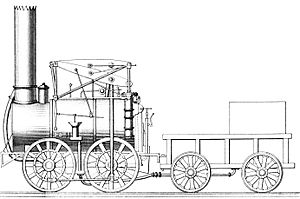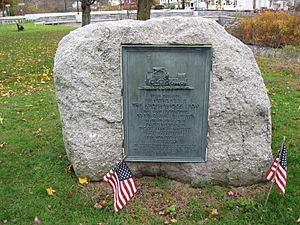Stourbridge Lion facts for kids
Quick facts for kids Stourbridge Lion |
|
 |
|
| The Stourbridge Lion's first run, as depicted by Clyde Osmer DeLand c. 1916 | |
| Power type | Steam |
|---|---|
| Builder | Foster, Rastrick and Company |
| Build date | 1829 |
| Configuration | 0-4-0 |
| Gauge | 4 ft 3 in (1,295 mm) |
| Driver diameter | 48 in (1.219 m) |
| Locomotive weight | 14,000 lb (6,400 kg; 6.4 t) |
| Tender weight | 5,800 lb (2,600 kg; 2.6 t) |
| Locomotive and tender combined weight | 19,800 lb (9,000 kg; 9.0 t) |
| Boiler | 48 in (1.219 m) dia. 10.5 ft (3.20 m) long |
| Fire grate area | 8 sq ft (0.74 m2) |
| Cylinder size | 8.5 in × 36 in (216 mm × 914 mm) dia. x stroke |
| First run | August 8, 1829 |
| Retired | 1834 |
| Current owner | Smithsonian Institution |
| Disposition | only the boiler remains; other parts were scrapped or stolen in the 1800s |
The Stourbridge Lion was an early steam locomotive used on railroad tracks. It was special because it was the first locomotive built outside the United States to run there. It was also one of the first locomotives to operate anywhere outside Britain. The name comes from a lion's face painted on its front. It was built in 1829 in Stourbridge, England, by Foster, Rastrick and Company.
The Delaware & Hudson Canal Company bought the locomotive. It arrived in New York in May 1829. After some tests, it was moved to Honesdale, Pennsylvania. There, it had its first real test run in August 1829. The Stourbridge Lion worked well, but it was too heavy for the tracks. Because of this, it was never used to pull coal wagons as planned. Over many years, parts of the locomotive were removed or lost. Today, only its boiler and a few other pieces remain. These parts are now owned by the Smithsonian Institution and are on display at the B&O Railroad Museum in Baltimore.
Contents
The Stourbridge Lion's Journey and Purpose
One of America's first railroads was the Delaware & Hudson Canal Company (D&H). It started in 1823 to build canals. These canals would move coal from mines in Carbondale, Pennsylvania, to New York City. By 1825, engineers at the company began thinking about using railroads. They planned to build a railroad from the mines to the canal. This would help get coal to the canal boats faster.
Designing the D&H Railroad System
John B. Jervis became the D&H's chief engineer in 1827. He later designed a famous type of locomotive called the Jervis type. Jervis designed a railroad system with sloped sections and flat parts. These flat sections were not connected to each other. The company leaders liked Jervis's plan. They decided to build it, even though railroad technology was still very new.
Ordering Locomotives from England
In 1828, Horatio Allen traveled to England. He was a former coworker of Jervis. Allen went to learn about railroads there. Jervis sent Allen details about the types of locomotives they needed. In July, Allen wrote back to say that four locomotives had been ordered. Three were from Foster, Rastrick and Company. One was from Robert Stephenson and Company.
The Stourbridge Lion was one of the three locomotives from Rastrick. However, Stephenson's locomotive, the Pride of Newcastle, was finished first. The Pride of Newcastle even arrived in America almost two months before the Stourbridge Lion. But it was the Stourbridge Lion that made the first test run. The Stourbridge Lion cost $2,914.90 when it arrived.
First Test Run in America
The locomotive traveled from Liverpool on a ship called the John Jay. It arrived in New York in mid-May 1829. Workers put it together at the West Point Foundry in New York. There, it was first tested using steam. Many people came to see the "critter" move.
Its first official run happened on August 8, 1829. This took place in Honesdale, Pennsylvania. An eyewitness said that steam was raised. Then, Horatio Allen drove the "wonderful machine." The crowd of people watching was very excited. Even though Allen had never driven a locomotive before, he took the Stourbridge Lion out alone. He drove it about three miles. This included a raised section over the Lackawaxen Creek. Then he drove it back to where he started.
The locomotive worked very well. But the tracks it ran on were not strong enough. The company had used iron strips on wooden rails, not all-iron rails. Jervis had said the locomotives should weigh no more than 4 tons. The Stourbridge Lion weighed almost double that, at 7.5 tons. The two other locomotives ordered, Delaware and Hudson, arrived later in 1829.
Similar Locomotives and Later Years
Rastrick built another engine around the same time. This engine, the Agenoria, was for use in England. It looked very similar to the Stourbridge Lion. However, it had a different track width and a much longer chimney. The Agenoria first ran in June 1829. It was used for over 30 years. Today, it is kept at the National Railway Museum in York, England.
By 1834, the D&H tried to sell the Stourbridge Lion and its sister engines. They offered them to the Pennsylvania Canal Commission. But the sale did not happen. These early locomotives were not suitable for the growing railroads. American companies had started making their own improved locomotives by 1830. The four English locomotives were used for their metal parts until the mid-1840s.
The Stourbridge Lion's Boiler and Legacy
By 1845, only the boiler of the Stourbridge Lion was left. The boiler still worked. It was used in a foundry in Carbondale for about five more years. Then, the foundry owner left to join the Forty-niners. New owners bought the foundry later. They knew the boiler was important history. In 1874, they tried to sell it for $1,000 but could not find a buyer.
In 1883, the D&H borrowed the boiler. They wanted to show it at an exhibition in Chicago. Sadly, the boiler was not well protected during transport. People who wanted souvenirs took parts off the historic boiler. They even used hammers and chisels to remove pieces.
The boiler was stored again. In 1890, the Smithsonian Institution bought it. A few other parts are believed to be from the Stourbridge Lion. However, it is not certain if they are truly original. These parts might have come from its sister engines. The museum has tried to rebuild the locomotive. But because some parts' origins are unclear, and some key parts are missing, it has not been fully rebuilt. The boiler and the parts that have been put together are now at the B&O Railroad Museum in Baltimore.
The D&H built its own copy of the Stourbridge Lion in 1932. They used plans based on the remaining parts. The Wayne County Historical Society Museum has a full-size copy of the Stourbridge Lion. It also has many photos and items related to it. This museum is in Honesdale, Pennsylvania. It was once the D&H Canal's office, where the Stourbridge Lion's first run began.
How the Stourbridge Lion Worked
The Stourbridge Lion's boiler was simple. It had a single pipe, or flue, for hot gases. The chimney came out of the top of the boiler. It did not have a separate smokebox door for cleaning. A large exhaust pipe was in front of the boiler. This pipe led to a blastpipe inside the chimney. You can see this exhaust pipe in many pictures of the locomotive.
The piston rods were connected to two "grasshopper beams." These beams were mounted above the boiler. One beam was for each cylinder. A connecting rod near the piston end of these beams moved the back wheels. This rod also connected to a coupling rod to move the front wheels.
Images for kids
See also
 In Spanish: Stourbridge Lion para niños
In Spanish: Stourbridge Lion para niños






